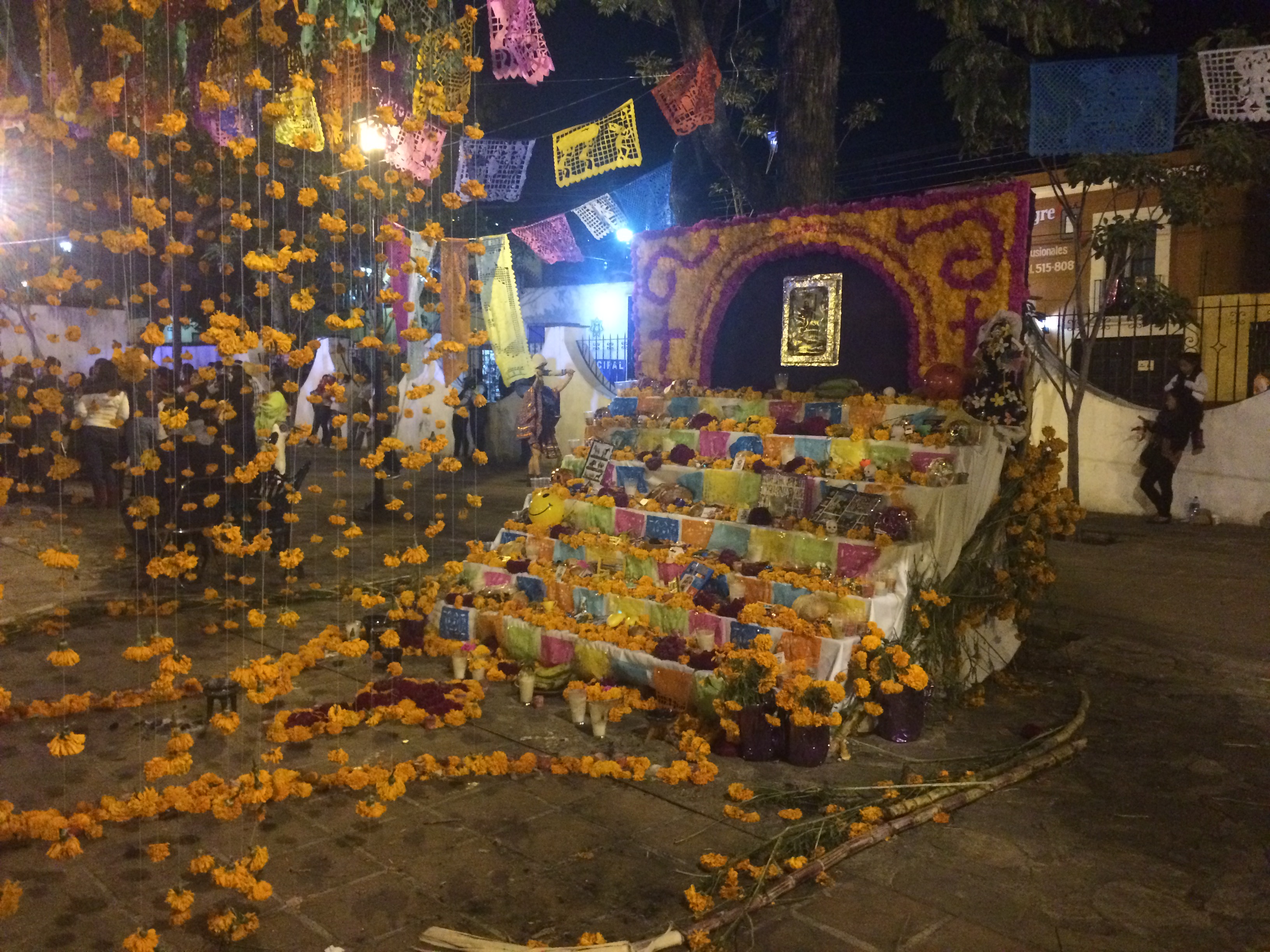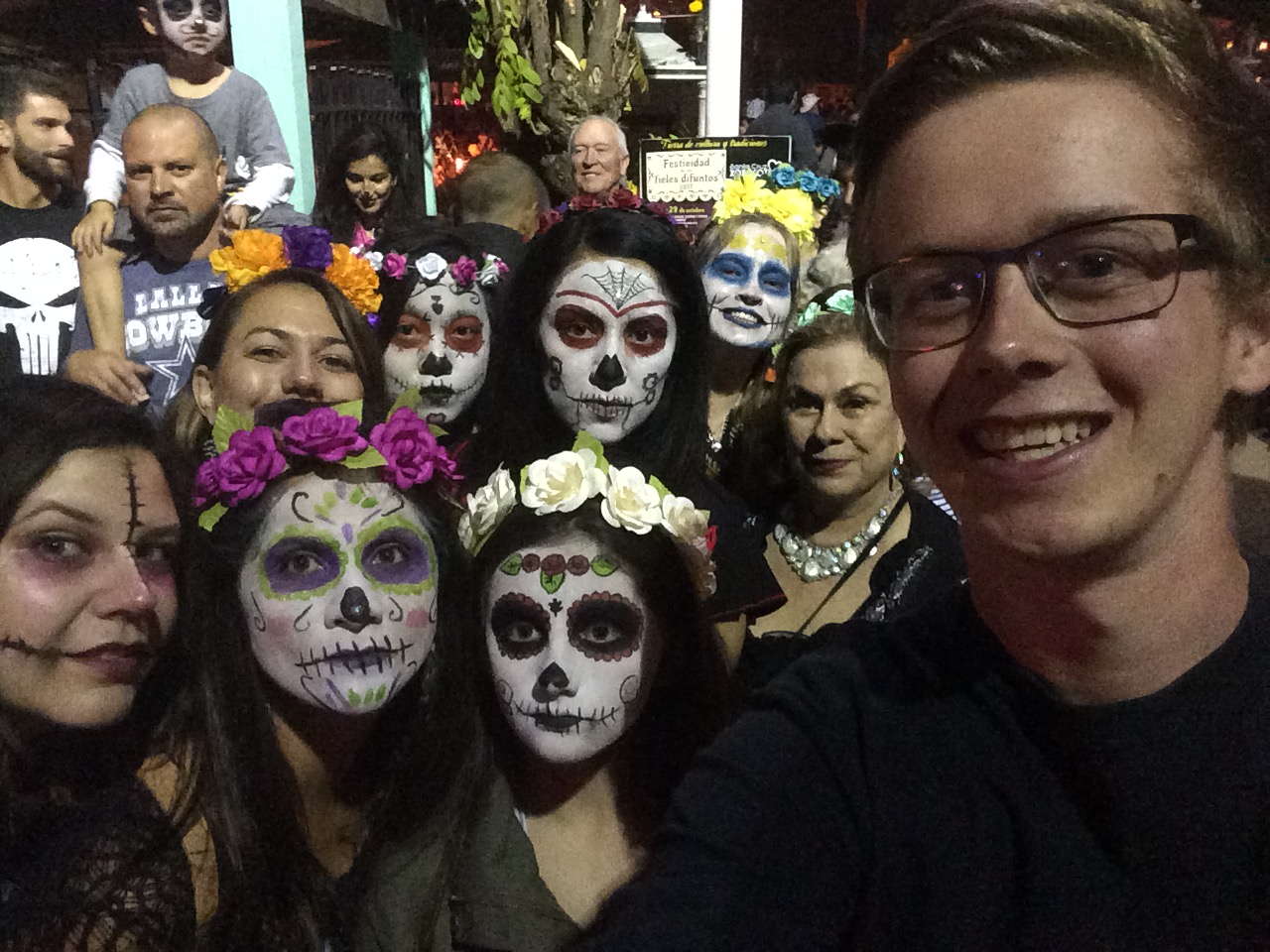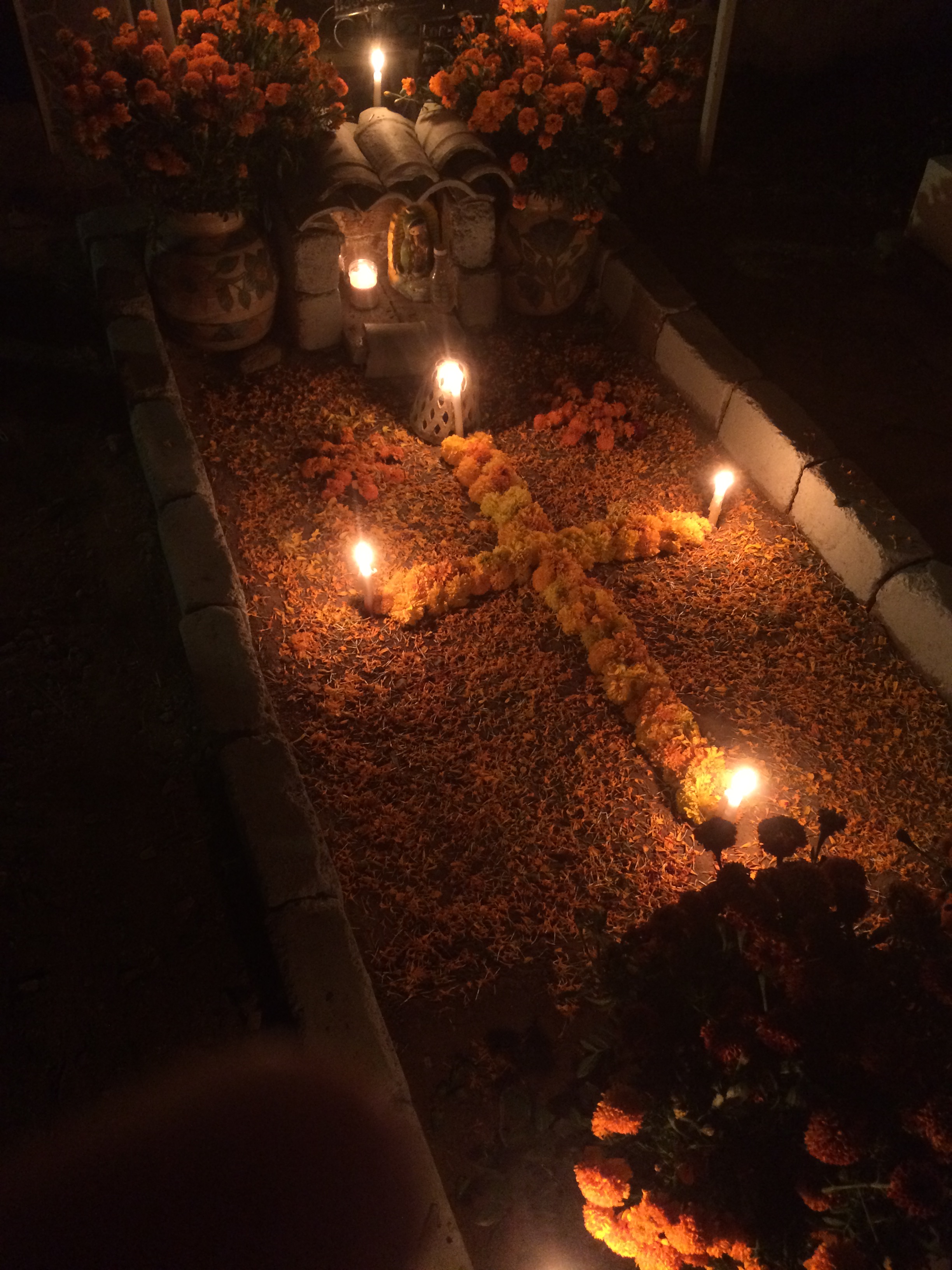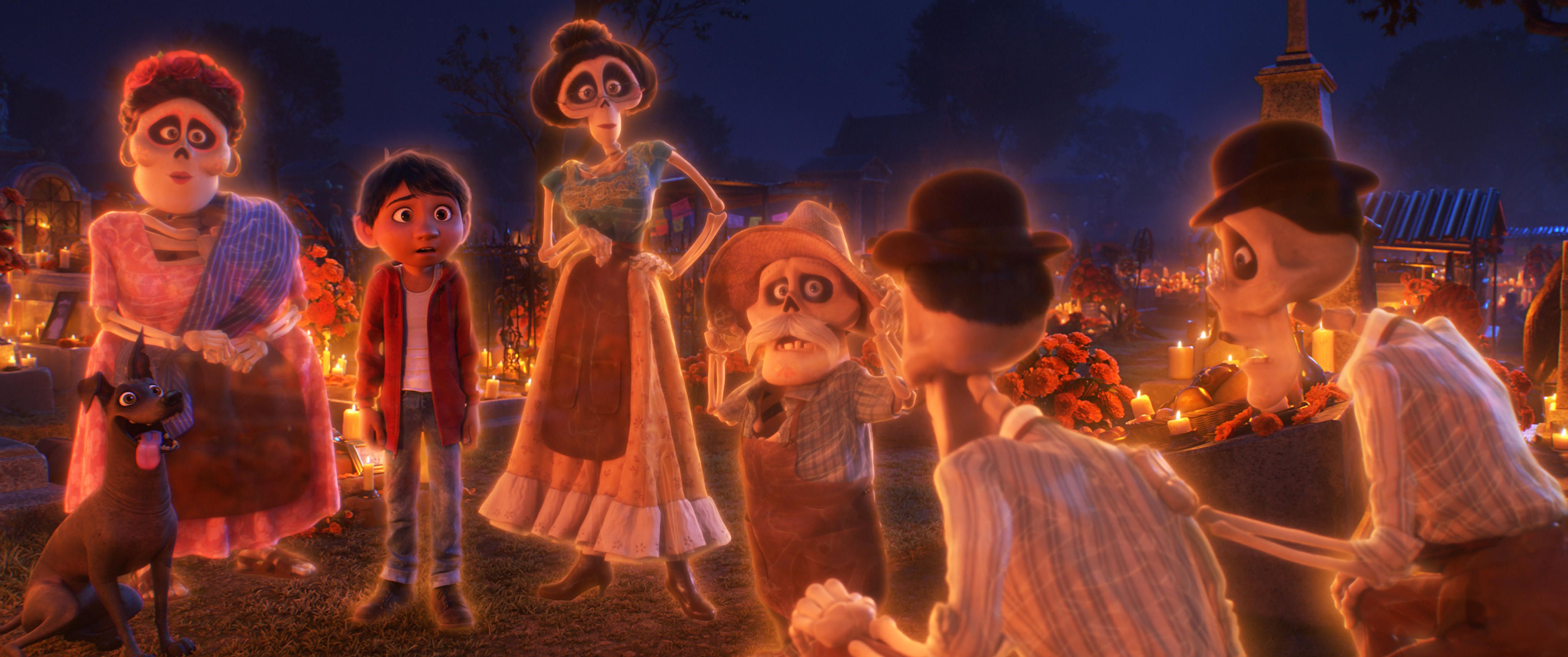
Día de los Muertos is a holiday in Oaxaca, México that brings together the community in a week of celebrations, festivals, and gatherings. It’s a community effort with preparations beginning weeks beforehand and lots of behind the scenes work. The week is filled with events that unite Oaxaca, including plays, live concerts, and daily parades. While arduous to describe, it is a unique cultural event that holds special significance for each person and community. These individualized experiences and celebrations vary widely across México. Here in Oaxaca, celebrations range from decorating a large altar or ofrenda in one’s house to spending the evening with deceased loved ones in the cemetery. There’s a certain intimacy surrounding the spirit of Muertos in México.
From my own experience living with a host-family here, Muertos was different than I anticipated. I expected an elaborate altar filled with marigolds or cempasúchil, food, and photos of deceased relatives. Instead, the weeks prior to the celebration consisted of my 23-year-old host brother decorating the house with fake cobwebs, a plethora of spooky dolls, and various other Halloween-themed items: from grim reapers to fake blood. The experience in my household was much more of a Halloween celebration than that of Muertos. In fact, our family hosted a Halloween party filled with music, drinks, and costumes. It was a different scene from what I began to see in the rest of the city.

As the celebration approached, the Cultural Institute of Oaxaca, my academic home here in Oaxaca, began decorating with altars, offerings and calaveras (skulls). Pan de Muerto (a traditional bread sold during Muertos) also began to emerge throughout the city bakeries. The spirit of Muertos was one of continuous excitement and flurried activity. The night of October 31st our entire group went to visit some of the local graveyards in the surrounding area of Oaxaca. Although it was pushing 10:00pm by the time we arrived, the town of Xoxocotlán was alive and celebrating in full force. Live music blasted into the stand-still of people trying to access the panteón (graveyard). Vendors selling various warm drinks and beer lined the streets. There were decorations, people in costumes, painted faces and more. It was packed as I tried to navigate the graveyard. Local Oaxacans filed up and down the pathways coming to meet their families at the tombs. They would sit around the grave of a long lost family member, typically in silence. While other times merrily chatting with others, holding a glass of mezcal, sometimes singing. Others present were clearly tourists, evidenced primarily by the large black cameras slung around their necks, spending more time trying to ‘capture’ the moment rather than experience it. Candles and flowers completely engulfed the panteón. Thousands of shining lights dancing in the night lined the gravestones. The deep significance of the celebration for those who were there was clear to me.
This night of Muertos continued at two more panteónes. Each brought similar sentiments as the first, with various types of music and food, and of course, mezcal. It is a time of celebration and remembrance for the families. However, I experienced it as a time of intrigue for the majority of the tourists including myself who were present this night. Although the families and I were at the same event, it was clear our intentions and ways of celebration differed. Undeniably, there isn’t one correct way to celebrate Muertos. There are different traditions between families (such as my own who valued Halloween) however each has their own merit. Each family seemed to practice their way of celebration in their own unique way. It is a celebration and party more than anything; it isn’t solemn in the traditional sense of the word.

At the third panteón we visited, in Atzompa, I had the opportunity to talk briefly with a woman who seemed to be there by herself. Alone but welcoming, she kindly answered some questions. I asked who she was sitting with tonight. She responded that it was her husband who had died 13 years prior. She continued to explain how every year she would spend the evening here in this graveyard. Her husband was the only member of her family who was buried in this graveyard. I was also able to speak with another family who had four generations present. The grandmother I spoke to was there with her daughter and granddaughter. They were spending the evening with the grandmother’s parents, who were buried side by side. Hearing these stories from families was incredibly powerful to me because it highlighted the importance of tradition and ancestry. There was a visible energy and connection between these families and their muertos, and it was an incredibly touching experience for me personally to hear at least a little bit about the lives of the families and those who are buried in these graveyards.
There is a distinct connection to family and many themes present that even now are hard to reflect on. These themes were once again brought up in a very powerful way for me after seeing the new Disney Pixar movie Coco (2017). Four friends and I had the opportunity to see Coco shortly after its release at a local movie theater in Oaxaca. Other than knowing that it was a Disney movie about México, I knew very little about the story. Without giving away too much, Coco follows the story of a young boy whose passion it is to play music. He gets tangled up visiting the grave of his idol, and suddenly finds himself in the world of the dead. In this world of the dead, he gets to meet his ancestors. His ultimate goal is to meet his music idol and receive his blessing to play music. Ultimately, Coco is a movie about self-discovery, family, death, and Muertos with nuanced details and characters brought to life, or death, as the case may be. It was strange to see characters, locations, and dialogue that are now customary for me. I have adapted to the culture here more than I realized, and this was noticeable while watching Coco. From the small narrow Mexican streets that I have been walking the last three months, to sounds of dogs barking in the streets that helped me fall asleep while in the city of Amatlán de Quetzalcoatl. It all seemed familiar. Watching the film, the first shot of the graveyard instantly transported me back to the night of the 31st. The candles. The environment. The sentiments. They were immediately familiar. It resonated at a profound level. The appreciation I had for the experience was elevated by my current immersion in México, especially having experienced these same events merely weeks prior.

A good friend of mine also currently living in México, in Ixtapán de la Sal, saw the movie as well. She shared a powerful message regarding the movie as a whole:
Coco has taken the place in my heart of my favorite work by Disney/Pixar. The storytelling elements and cultural relevance to my current journey have allowed me to better understand my own experience of Muertos in an engaging and comprehensible way. It has helped me better understand the family dynamics in México and the importance of traditions such as Muertos in this culture.
For those of you who are interested in the opportunity to begin to learn more about the tradition of Día de los Muertos, Coco is an incredible first step. Although it cannot begin to describe the feelings and sentiments of what being in Oaxaca for Muertos is really like, it offers an important view of one particular way of celebrating as well as the traditions and values that shape life in Mexico.
Thank you for sharing your story!